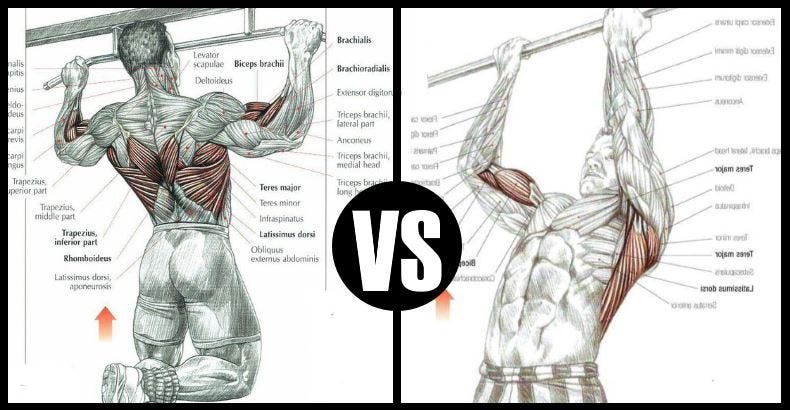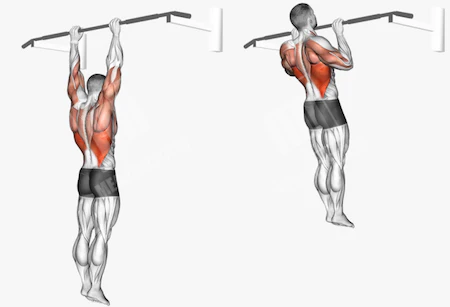When it comes to building upper body strength, chin-ups and pull-ups are two of the most effective exercises you can include in your workout routine. But while these two moves may look similar, they differ in key ways, from grip style to the specific muscles they target. This article explores the difference between chin-ups and pull-ups, their unique benefits, the muscles they work, and which one might be better suited for your fitness goals. If you've ever wondered, "Are chin-ups and pull-ups the same?" or "Are chin-ups or pull-ups better?", you've come to the right place. Follow us here at New Venus Petite Collection
The Difference Between Pull-Ups and Chin-Ups
The main difference between chin-ups and pull-ups lies in the positioning of your hands and how each grip affects your workout. In a chin-up, your palms face toward you (a supinated grip), whereas, in a pull-up, your palms face away (a pronated grip). This seemingly small difference has a big impact on how the exercise feels and which muscles are engaged. Chin-ups are generally easier for most people, as they involve more assistance from the biceps, while pull-ups tend to be more challenging due to their focus on the back and shoulder muscles.

Related: The Ultimate Gen Z Guide to Building Muscle Tag
Related: Why Fitness Bootcamps Are the New Luxury Vacation for Gen Z
Related: Surprising Facts About Mesomorphs, Ectomorphs & Endomorphs
Chin-Ups

Chin-ups are an upper-body exercise that primarily works the latissimus dorsi (lats) and the biceps. When performing a chin-up, the supinated grip (palms facing you) allows your biceps to play a larger role in the movement, making it easier for beginners to perform compared to pull-ups. This movement is ideal for those looking to build stronger biceps and forearms. One question that often comes up is: "Are chin-ups as good as pull-ups?" The answer depends on your goals. If you’re focusing more on bicep strength and development, chin-ups might be more beneficial for you.
Pull-Ups

Pull-ups, on the other hand, use a pronated grip (palms facing away), which shifts more of the workload to the upper back and shoulders. The muscles engaged during pull-ups include the lats, rhomboids, and trapezius, with less assistance from the biceps. Many fitness enthusiasts debate whether "Are pull-ups better than chin-ups?", and the answer often boils down to personal preference and fitness goals. For those aiming to build a wider, more sculpted back, pull-ups are generally considered the superior option.
Correct Form: Chin-Ups & Pull-Ups
Performing both exercises with the correct form is crucial to avoid injury and maximize effectiveness. For both movements, start by gripping the bar with your hands shoulder-width apart. Engage your core, keep your body steady, and avoid swinging or using momentum. Pull yourself up until your chin clears the bar, then lower yourself slowly. Maintaining a controlled movement helps target the intended muscles while reducing the risk of strain.
Risks and Injury Prevention
Despite their benefits, chin-ups and pull-ups carry certain risks, particularly if performed incorrectly or without proper warm-up. Key areas of concern include:
Shoulder Strain
Both exercises put considerable stress on the shoulders, and improper form can lead to strain or injury. Ensuring you warm up adequately and don’t force movements beyond your strength level will help prevent shoulder issues.
Elbow Tendonitis
Elbow tendonitis is another common injury associated with chin-ups and pull-ups. This occurs when the tendons in the elbow become irritated from repetitive strain. Varying your grips and avoiding overtraining can help reduce the risk of tendonitis.
Variations of Pull-Ups and Chin-Ups
To keep your workouts fresh and target different muscles, try incorporating different variations of these exercises. Whether you're looking to add intensity or simply change things up, these variations can help you reach your goals:
Neutral Grip Pull-Ups
This variation involves gripping the bar with your palms facing each other, which provides a balance between chin-ups and pull-ups. It engages the biceps more than a pull-up but still works the back muscles.
Wide Grip Pull-Ups
For those wondering if "Are pull-ups or chin-ups harder?", wide grip pull-ups are often considered one of the toughest variations. By widening your grip, you engage your lats more, making the exercise more challenging.
Close Grip Chin-Ups
In this variation, your hands are closer together than in a standard chin-up. Close grip chin-ups place additional focus on the biceps and forearms, helping to develop upper-arm strength.
Assisted Pull-Ups and Chin-Ups
If you're still building strength, assisted pull-ups or chin-ups using resistance bands or an assisted machine are great options. These tools provide additional support, allowing you to work on proper form without overstraining your muscles.
Benefits of Pull-Ups and Chin-Ups
Both exercises come with a range of benefits, which is why they're so popular in fitness routines across the world. Let’s take a closer look at why you should include pull-ups and chin-ups in your workout:
Strengthens Upper Body Muscles
Both exercises are fantastic for strengthening your upper body. Chin-ups focus more on the biceps and forearms, while pull-ups target the back and shoulders, making them complementary exercises for complete upper-body development.
Improves Grip Strength
One often overlooked benefit of these exercises is how they improve grip strength. Whether you're lifting weights or doing daily activities, a stronger grip helps in various areas of fitness and life.
Functional Movement
Chin-ups and pull-ups mimic natural pulling movements, making them excellent for improving functional strength. This translates into better performance in other exercises and daily tasks, such as lifting or pulling objects.
Convenience and Accessibility
Both chin-ups and pull-ups require minimal equipment, making them accessible to most people. A simple pull-up bar installed at home or at the gym is all you need, making these exercises convenient for almost any fitness regimen.
Example Pull-Up & Chin-Up Workout Routine
If you’re ready to incorporate both exercises into your workout routine, here’s a simple yet effective plan that combines chin-ups and pull-ups:
Exercise | Set X Reps |
Warm-Up (Dynamic Stretching) | 5-10 Minutes |
Pull-Up | 3 x 6-8 |
Chin-Up | 3 x 6-8 |
Wide Grip Pull-Up | 3 x 4-6 |
Close Grip Chin-Up | 3 x 4-6 |
Assisted Pull-Up/Chin-Up | 3 x 8-10 (if necessary) |
Cool-Down (Stretching) | 5 Minutes |
This workout balances both exercises and their variations, ensuring you target a variety of muscles while building strength progressively.
Conclusion
Chin-ups and pull-ups may seem similar, but their differences in grip and muscle engagement make them unique exercises with their own set of benefits. Whether you're asking "Are chin-ups easier than pull-ups?" or "Are pull-ups better than chin-ups?", the truth is that both exercises offer excellent upper-body development when incorporated into a balanced fitness routine. As fitness trends evolve, these timeless exercises remain staples due to their simplicity, effectiveness, and ability to be adapted to any skill level. With a solid understanding of proper form, variations, and injury prevention, you can confidently integrate both chin-ups and pull-ups into your workout routine and reap the rewards.